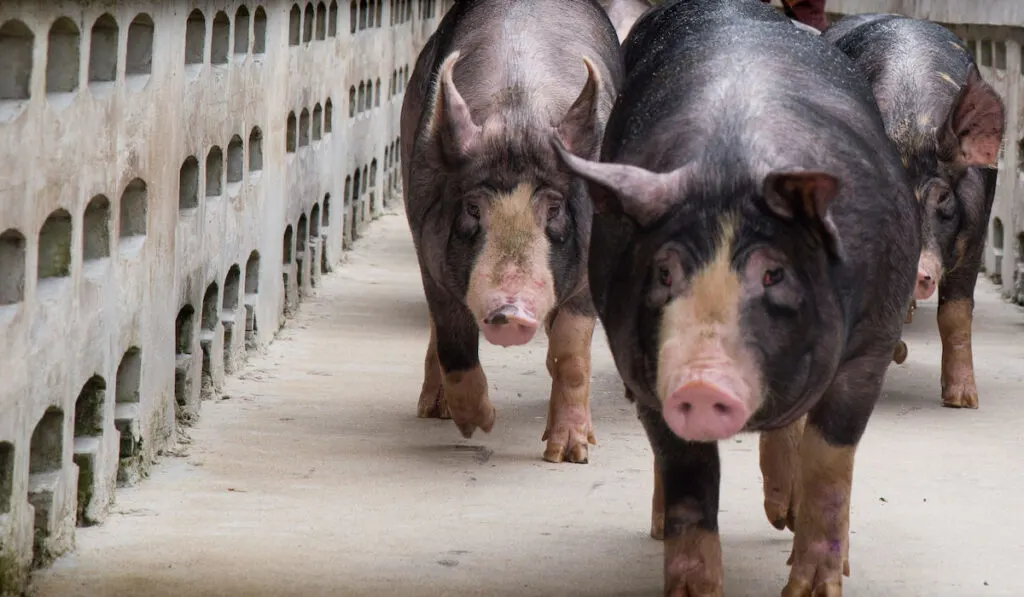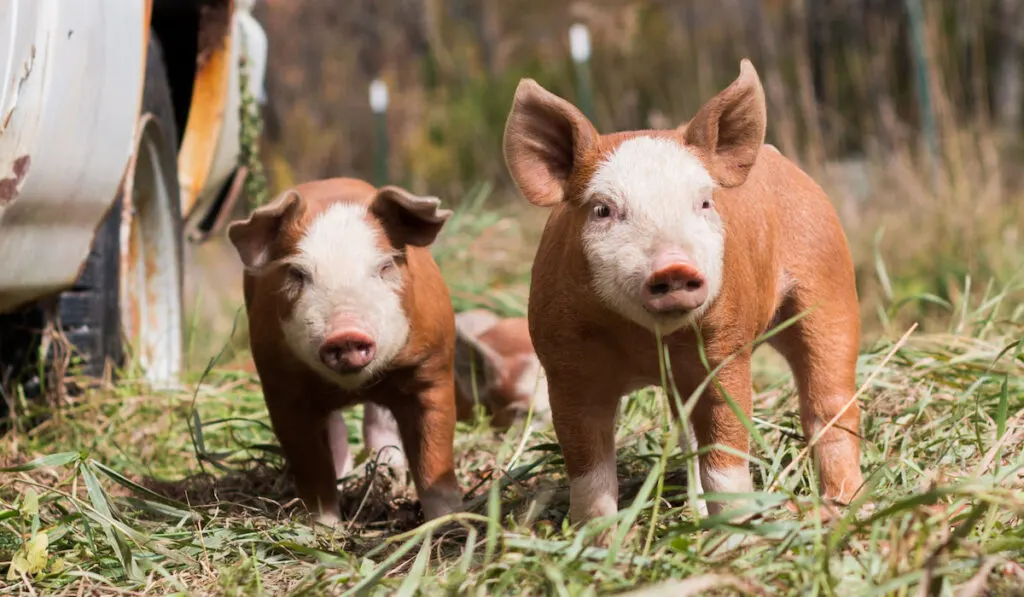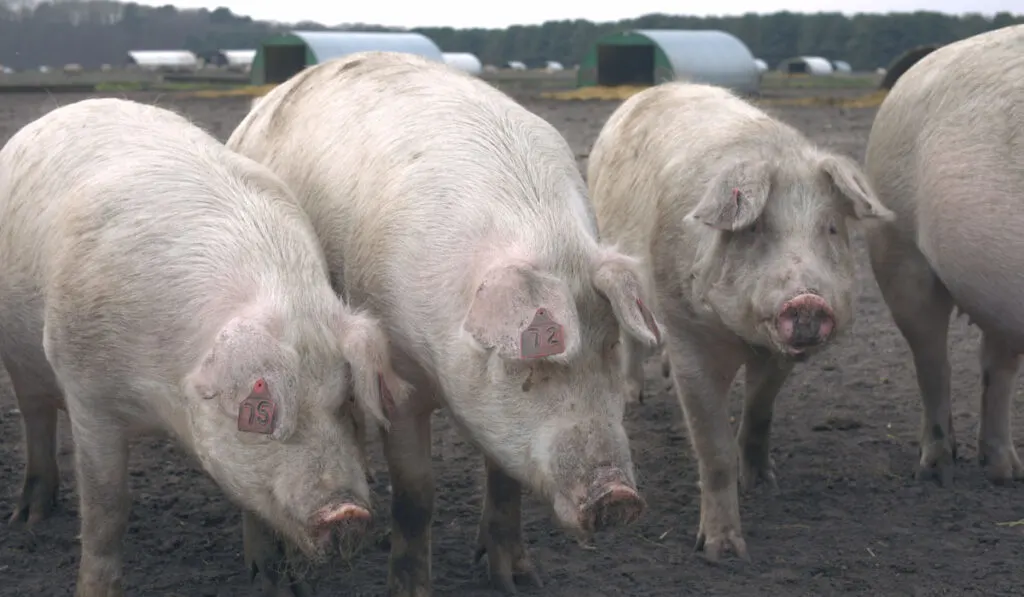Pigs have wonderful, flavorful meat. Pork chops, bacon, and sausages are some products of pigs.
Unknown to many, individual pig breeds have pros and cons to raising them. There are some pig breeds kept for their meat which are more profitable than others.
You’ll want to read along if you’re looking to raise pigs on your farm.
Our detailed guide lists some of the best pig breeds for meat. We also explore their characteristics and what to expect when keeping them.
Table of Contents
9 Best Meat Pig Breeds
Some of the most common pig breeds for meat are:
Berkshire pigs

Berkshire pigs are famous for their quality and taste of meat. Their pork is known to be tender, juicy, and full of flavor.
The meat also has high-fat content, which is ideal for high temperatures and long cooking.
Originally from Berkshire in the UK, these pigs are one of the oldest breeds in England. Back in the day, they were rougher and bigger, and they were light red to black.
Modern Berkshire pigs are predominantly black and have white on their face and legs. Their erect ears point forward, and their tail tips have white markings.
These pigs are reared for fresh pork production.
They are common in England, North and South America, and Japan. Countries like New Zealand and Australia keep them for their unique bacon.
The breed is intelligent and likes to forage. They also do well in confinement and extensive piggery farming systems. That aspect makes them ideal for small-scale production.
You can also keep Berkshire pigs if you have a spacious backyard farm.
These pigs adapt well to all climates.
Another impressive aspect is that the pig takes about 180-190 days to get to 250 lbs (113 kg), which makes it a fast-growing breed.
Chester Pigs
Chester pigs are from Pennsylvania’s Chester County. They are referred to as Chester White and were first developed in the 1800s using white boars and other white pigs in Northeast U.S.
These pigs are white and have medium-sized, hanging ears. Their snout is pink and is used to look for food.
The sow weighs about 496-650 lbs (225-295 kg), while the boar weighs between 551-772 lbs (250-350 kg). This breed is best for rigorous and large-scale farming as it’s considered adaptable.
Additionally, Chester pigs can gain weight fast. Research shows that for every three pounds of feed, they can gain close to one pound.
Chester white pigs are kept for meat like pork chops, bacon, sausage, and ham. Their meat has a high-fat content.
Something to note is that the Chester pig may be susceptible to sunburn due to its pale body color. They need access to shade when it’s very hot to prevent this.
Duroc Pigs

Duroc pigs are one of the oldest breeds in the U.S. and are reared for their quality, well-marbled meat.
While some theories suggest that these pigs are from the United Kingdom, research shows that Duroc pigs originated in the United States. According to the National Swine Registry, Duroc pigs are a crossbreed between Old Durocs and Jersey Reds.
The medium-sized pig weighs about 770-880 lbs., which is why they are popularly bred for meat.
Their red color ranges from dark to light. Duroc pigs have longer bodies, hanging ears, and concave-like faces in the middle.
One outstanding feature about Durocs is that they can withstand any climate. They have thick coats and skin that come in handy during the cold season.
Their docile nature makes them suitable for farm life. They are also personable and friendly, which makes them perfect around other livestock.
Duroc pigs grow quickly and can gain full size in two years. These pigs are also valued for their mothering ability and resistance to diseases.
Hereford

The Hereford pig or Hereford hog was developed in the mid-90s from a synthesis of Poland China, Chester White, and Duroc pigs. It’s one of the rare pig breeds.
These pigs are common in Indiana, Iowa, and Illinois.
Hereford pigs get their name from their unique pattern and color that resembles the Hereford cattle breed.
These pigs have white and red-brown coloration. Furthermore, their faces are slightly dished and of medium length, while their ears are floppy and medium-sized.
Mature boars weigh about 795 lbs (360 kg), while sows average around 595 lbs (270 kg).
You can keep this breed for intensive and extensive farming as it’s hardy and adapts well to different climates.
You’ll love the Hereford’s docile and friendly nature as a new pig farmer.
Another reason you should consider keeping these pigs is their ability to reach maturity earlier and faster. Herefords can get to 243 lbs (110 kg) within six months of age.
They also have excellent mothering ability and produce large litters.
Hampshire

According to the American National Swine Registry, Hampshire is the fourth most recorded pig breed in the U.S.
It’s believed that it originated in Scotland and Northern England and was later introduced to the United States in early 1830.
Hampshire pigs are medium-sized and have black bodies with a whitish band around their middle. They also have erect ears, long noses, and well-built legs.
A mature boar weighs about 660 lbs (300 kg) and averages 550 lbs (250 kg). Their well-built and heavy bodies make them ideal for meat production. The meat is lean and of good quality.
Besides their longevity, the Hampshire pigs also have a good temperament and make great mothers.
Beginner farmers will find this breed fantastic as they mature quickly and breed easily. Their docile nature, intelligence, and calm temperament make them an excellent addition to any farm.
Landrace Pigs

Landrace pigs are raised for commercial pig farming. It’s believed to be from Sweden and Denmark, where it was kept for its quality meat.
They developed from crossing the Large White pig and the native pig in Denmark.
Different Landrace pig breeds are the Danish Landrace, American Landrace, Belgian Landrace, French Landrace, and more.
Modern Landrace pigs are developed from selective breeding instead of natural selection.
These pigs have white skin, droopy ears that slant forward, long snouts, and long bodies. A mature boar weighs about 700 lbs (318 kg), while the sows average about 600 lbs (272 kg).
Landrace pigs are prolific breeders and can cross well with other breeds.
They have long bodies, and most of their carcass weight is in the loin and ham.
As a pig farmer, you’ll love how Landrace pigs grow fast and mature more quickly than most pig breeds.
Their excellent mothering nature and ability to produce large litters make them ideal for small-scale farming.
Pietrain Pigs

The Pietrain pig is from Belgium, and it’s believed to be a cross of the Yorkshire and Berkshire breeds.
They were later exported to other countries when there were problems in the pork market in Germany.
These pigs have white skin; some may have black and gray spots on the back. They have erect, small ears, short legs, and a cylindrical trunk with well-developed muscles.
Pietrain pigs have a small head, short snout, and a broad sacrum.
Although the sows are prolific breeders, they lack mothering characteristics.
Pietrain pigs are known for their high-quality meat with low-fat content.
Yorkshire

The Yorkshire pig breed is a domestic breed and one of the most sought-after worldwide due to its quality bacon.
The breed is originally from England, bred into a large and productive breed by Robert Bakewell. That makes it one of the largest white pigs.
Yorkshire pigs are white but appear pale pink on close observation. They have a well-built body, a slightly dished face, a long head, and long legs. Their ears are erect and stand upright.
They have a medium-sized snout and a small nose, while their tails are curly.
Sows weigh about 660 lbs (300 kg), while the boars weigh close to 770 lbs (350 kg).
Yorkshire pigs are friendly and have a docile temperament. They are easy to instruct and mindful of their surroundings, making them suitable for beginner pig farmers.
They also care for their young ones. However, depending on their treatment, these pigs can also be emotional and moody.
These pigs mature fast and can gain up to 255 lbs (115 kg) in about six months.
The Yorkshire pig is an excellent pork rib, chops, and bacon source. Their lean meat is widely recognized.
Final Thoughts
Pig farming is a profitable and rewarding venture. Our list above has some of the best pig breeds for meat. They all have their advantages and shortcomings.
Be sure to find a breed suitable for your farming endeavors.
Resources
- https://www.thepigsite.com/focus/advertiser/3654/the-different-breeds-of-swine-berkshire-berkshire-pig-breed-berkshire-gilts-sows-and-boars
- https://www.britannica.com/animal/Hampshire-breed-of-pig
- https://www.breedslist.com/chester-white-pig.htm
- https://www.thepigsite.com/breeds/chester-white
- https://www.livestocking.net/duroc-pig-facts#Productive_Characteristics_of_Duroc_Pigs
- https://northernnester.com/duroc-pigs/
- https://livestockconservancy.org/heritage-breeds/heritage-breeds-list/hereford-pig/
- https://nationalswine.com/resources/docs/education/ideal_flyers/hampshire_ideal_flyer.pdf
- https://www.roysfarm.com/hampshire-pig/
- https://nationalswine.com/resources/docs/education/ideal_flyers/landrace_ideal_flyer.pdf
- https://www.roysfarm.com/american-yorkshire-pig/
- http://afs.okstate.edu/breeds/swine/pietrain/index.html/
